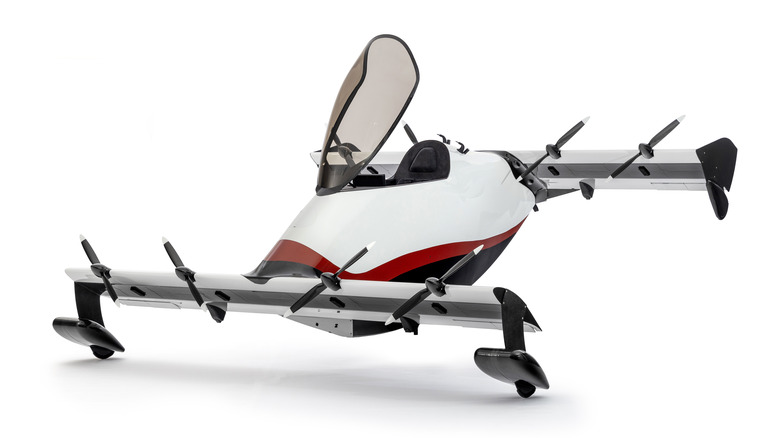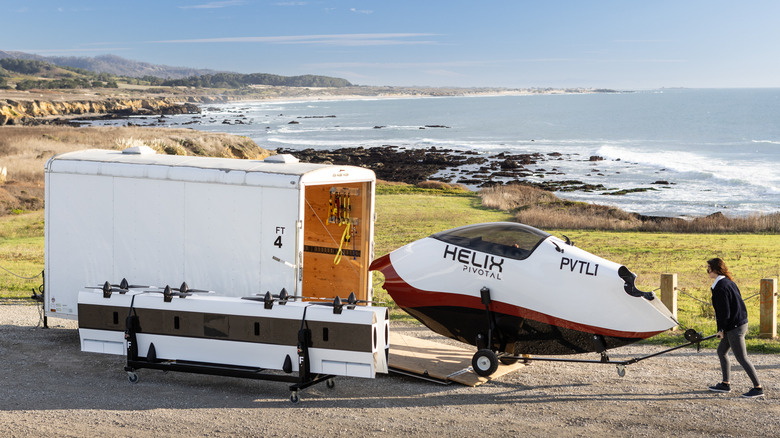This New eVTOL Aircraft Can Be Flown By Anyone, Even Without A Pilots License
Pivotal (formerly known as Opener) has recently begun taking orders for its first light eVTOL (electric vertical take-off and landing) aircraft produced at scale. Based in Palo Alto, California, Pivotal has been working on the Helix for over 12 years, but is actually its fourth-generation eVTOL.
Helix is a single-seat PAV (Personal Aerial Vehicle) tilt aircraft with fixed rotors and tandem wings classified by the FAA as Part 103 Ultralight, so it doesn't require a pilot's license. While at this past Consumer Electronics Show in Vegas, CEO Ken Karklin said, "It lacks the complexity that just about any other eVTOL has." He added that there are no rotating wings or motors, and the Helix only has 12 control surfaces instead of the dozens more typically found on other craft.
The Helix is made with a carbon fiber composite and is controlled by a joystick with fly-by-wire controls. Without a pilot, it only weighs 348 pounds. A diminutive height of 5 feet 3 inches, a width of 13 feet 7 inches (with nearly the same length), and 33.13 square feet of the wing allow it to fit inside a 16-foot trailer for transport when entirely collapsed down.
Pack it up and go
The ultralight's batteries hold 8 kilowatt-hours of total storage and have a range of some 20 miles (with a 20% reserve), with a cruising speed of 55 knots (63 mph), a maximum climb and descent rate of 500 fpm, and a full static thrust of 960 pounds. It only consumes 245 watt-hours per mile compared to an electric car's 270 and takes 75 minutes to fully recharge (from a 20% level) if using a 50-amp Level 2 charger. It'll take much longer (4.5 hours) if plugged into a 15-amp 120-volt Level 1 wall socket.
The company's goal was to make an elegant yet simple aircraft, not get into the air taxi service business or become a provider of vehicles for air taxi services (one of which just set a new record for the longest eVTOL flight). However, its simplicity doesn't mean you can just hop in and go, as Pivotal puts prospective buyers through rigorous simulator and flight training sessions. If the five "simple" questions on its website are any indication, there are some significant restrictions as to who can fly it and where it can be flown.
First, you have to be over the age of 18. Due to airframe and canopy limitations, the pilot must have a seated height of no more than 3 feet 3 inches and a standing height of 6 feet 5 inches. And because of the craft's thrust and battery reserve, the pilot must weigh less than 220 pounds.
Personal aerial vehicles are finally in reach ... for a price
The Helix must be flown over non-congested areas and away from airports. It has a maximum ceiling of 5,000 feet above sea level, can't be flown in rain, at night, in wind gusts greater than 17 knots (20 mph), and temperatures must be between 14 degrees Fahrenheit and 91 degrees Fahrenheit.
Customers in the U.S. can order the Helix in three different packages with varying levels of customization starting at $190,000 (before taxes, delivery, and other fees), which includes the basics like a canopy, HD landing camera, digital flight panel, and vehicle cart among other things. The second level offering boosts the price to $240,000, and gets you some upgrades like a trailer with a dual-wing cart, a 4K landing camera with recording and sharing features, and an ADS-B air traffic system. At $260,000, the final level gets additional upgrades like a premium flight deck, beacon lights, and an emergency locator transmitter. The Helix is amphibious in case an emergency landing occurs in water.
Given the cost, most people will likely only experience eVTOLs when an autonomous self-piloting aircraft delivers their online shopping before actually hopping into one of their own. Despite that, Pivotal expects shipments to start going out on June 10, 2024.

